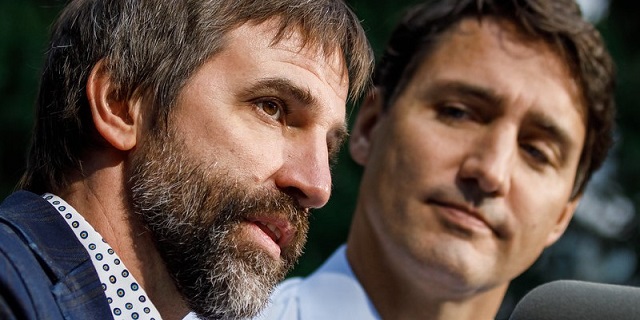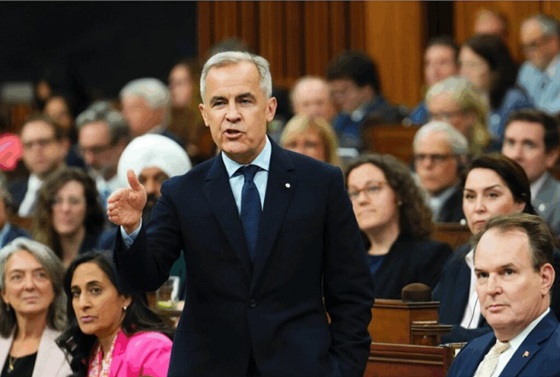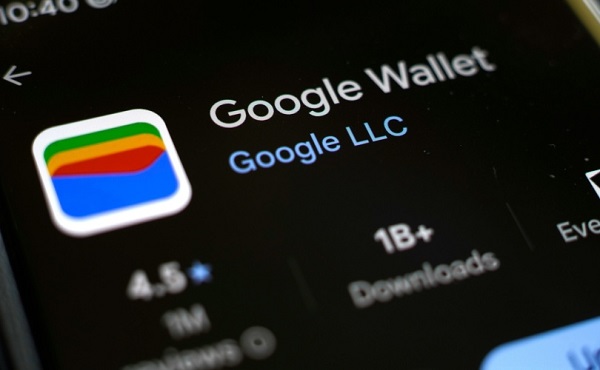National
Federal government touts climate ‘crisis’ without sufficient supporting evidence

From the Fraser Institute
Canada is, we are told, in a climate crisis. “Climate action can’t wait,” said Prime Minister Trudeau. “Together, we will beat this crisis while creating a green economy and new middle-class jobs for Canadians.” In a Guardian article, federal Environment Minister Steven Guilbeault said “the science is clear” that the “climate crisis is the biggest single threat we face as a global community.” And of course, the government’s new “Raising the Bar” campaign is very alarming, particularly the stuff about droughts and floods.
But have we seen significant increases in weather extremes? Is the strength of evidence sufficient to justify the panic-mongering language of a “climate crisis?” In a nutshell, no.
Let’s start with drought. The vaunted UN Intergovernmental Panel on Climate Change (IPCC) asserted “medium confidence” that increased drought has been observed across the globe. And in the Royal Society, one of oldest scientific academies on Earth, an international research team dug into the data only to find that in the “vast majority of the world, trends in meteorological drought duration and magnitude are not statistically significant, with the exception of some small regions of Africa and South America, which is also where data uncertainty is greater” concluding that “trends in meteorological drought severity in the last few decades are not observed globally based on precipitation data, and very few areas are showing changes in the severity of meteorological droughts.” Finally, according to the International Energy Agency, drought severity in Canada from 2000 to 2020 was only slightly above the global average.
Well, but what about floods?
Canada has plenty of those. The IPCC report finds it “likely” that heavy precipitation events (a major cause of flooding) have increased globally, at least over land areas with good data. The report has less confidence in places such as Africa and South America where we’re reminded the people are at higher risk from climate change because they’re poorer and less likely to adapt. But a 2017 report of the United States Global Climate Research Project found that while “detectable changes in some classes of flood frequency have occurred in parts of the United States” there’s no “significant connection of increased riverine flooding to human-induced climate change, and the timing of any emergence of a future detectable anthropogenic change in flooding is unclear.” Further, a recent UN report found with “high confidence” that “streamflow trends since 1950 are not statistically significant in most of the world’s largest rivers, while flood frequency and extreme streamflow have increased in some regions.” Does that sounds like a crisis?
The Trudeau government’s climate rhetoric has steadily ratcheted up over years, and settled on the panic-inducing language of “crisis.” We must follow government’s energy-diet, live smaller, less prosperous lives in less space, with less travel, and less, well, everything. Of course, the crisis rhetoric allows for no doubts, being absolutist in its claims that we are—right now—experiencing major increases in natural disasters fuelled by human-sourced greenhouse gas emissions.
But clearly, the scientific literature on extreme weather does not support this rhetoric. The actual data on extreme weather is scant, fragmented, contradictory and in all ways uncertain. It’s certainly not rigorous enough to justify the kind of exaggerated certainty Ottawa asserts nor the induction of climate panic.
Author:
Health
Canadian gov’t considers sharing census data on gender-confused children

From LifeSiteNews
Statistics Canada recently consulted LGBTQ+ groups on releasing 2021 census data about gender-confused children ages 0-14, citing research that toddlers could be ‘transgender.’
Statistics Canada is seeking to collect and share data on gender-confused children in its latest move to promote the LGBT agenda to minors.
From November to mid-December, Statistics Canada held consultations with various LGBT groups to discuss how to release 2021 census data on gender-confused children ages 0-14, according to a report shared with the National Post.
“For the upcoming 2026 Census, Statistics Canada has been consulting with the Canadian population, experts and stakeholders on gender,” the government agency wrote in a recent report.
“The Agency has finished conducting extensive qualitative and quantitative testing, notably to assess the impact of modifying the gender response categories to include ‘man’ and ‘woman,’ and ‘boy’ and ‘girl’ for those younger than 15 years,” it continued.
In 2021, StatsCan conducted the first-ever census to collect data on sex assigned at birth as well as how Canadians later ‘identified’ as their gender. The census collected data from Canadians of all ages but only published that of Canadians 15 years and older.
According to the information, released April 2022, 0.33% of the Canadian population age 15 or older were gender-confused, with 0.19% believing they are transgender and 0.14% believing they are non-binary.
The report noted that “younger generations may be more comfortable reporting their gender identity than older generations.”
Now, StatsCan is seeking to further push the LGBT agenda on young children by releasing data to support their argument that young children can be “transgender.”
According to a copy of its most recent report, “children and youth are often assumed to be cisgender (people whose reported gender corresponds to their birth sex) from birth until they ‘come out’ as a different gender on their own accord.”
“Researchers suggest that children aged 18 to 24 months are developmentally capable of recognizing gender norms and expressing gendered behaviours in visible ways,” it continued.
“Research also suggests that, like cisgender children, transgender and non-binary children may recognize their own gender identity as early as 2 to 3 years old or during later childhood or early adolescents,” the document read.
The StatsCan report conveniently ignores scientific data on the harms of gender-transitioning interventions, both on the physical and mental health of individuals, particularly children.
A significant body of evidence shows that “affirming” gender confusion carries serious harms, especially when done with impressionable children who lack the mental development, emotional maturity, and life experience to consider the long-term ramifications of the decisions being pushed on them, or full knowledge about the long-term effects of life-altering, physically transformative, and often irreversible surgical and chemical procedures.
Studies find that more than 80 percent of children suffering gender dysphoria outgrow it on their own by late adolescence and that “transition” procedures, including “reassignment” surgery, fail to resolve gender-confused individuals’ heightened tendency to engage in self-harm and suicide – and even exacerbate it, including by reinforcing their confusion and neglecting the actual root causes of their mental strife.
As LifeSiteNews has previously noted, research does not support the assertions from transgender activists that surgical or pharmaceutical intervention to “affirm” confusion is “necessary medical care” or that it is helpful in preventing the suicides of gender-confused individuals.
In fact, in addition to asserting a false reality that one’s sex can be changed, transgender surgeries and drugs have been linked to permanent physical and psychological damage, including cardiovascular diseases, loss of bone density, cancer, strokes and blood clots, infertility, and suicidality.
There is also overwhelming evidence that those who undergo “gender transitioning” are more likely to commit suicide than those who are not given irreversible surgery. A Swedish study found that those who underwent “gender reassignment” surgery ended up with a 19.2 times greater risk of suicide.
Indeed, there is proof that the most loving and helpful approach to people who think they are a different sex is not to validate them in their confusion but to show them the truth.
A new study on the side effects of transgender “sex change” surgeries discovered that 81 percent of those who had undergone “sex change” surgeries in the past five years reported experiencing pain simply from normal movement in the weeks and months that followed — and that many other side effects manifest as well.
Alberta
Canada’s New Green Deal

From Resource Works
Nuclear power a key piece of Western Canadian energy transition
Just reading the headlines, Canadians can be forgiven for thinking last week’s historic agreement between Alberta and Ottawa was all about oil and pipelines, and all about Alberta.
It’s much bigger than that.
The memorandum of understanding signed between Canada and Alberta is an ambitious Western Canadian industrial, energy and decarbonization strategy all in one.
The strategy aims to decarbonize the oil and gas sectors through large-scale carbon capture and storage, industrial carbon pricing, methane abatement, industrial electrification, and nuclear power.
It would also provide Canadian “cloud sovereignty” through AI computing power, and would tie B.C. and Saskatchewan into the Alberta dynamo with beefed up power transmission interties.
A new nuclear keystone
Energy Alberta’s Peace River Nuclear Power Project could be a keystone to the strategy.
The MOU sets January 1, 2027 as the date for a new nuclear energy strategy to provide nuclear power “to an interconnected market” by 2050.
Scott Henuset, CEO for Energy Alberta, was pleased to see the nuclear energy strategy included in the MOU.
“We, two years ago, went out on a limb and said we’re going to do this, really believing that this was the path forward, and now we’re seeing everyone coming along that this is the path forward for power in Canada,” he said.
The company proposes to build a four-unit, 4,800-megawatt Candu Monark power plant in Peace River, Alberta. That’s equivalent to four Site C dams worth of power.
The project this year entered a joint review by the Impact Assessment Agency and Canadian Nuclear Safety Commission.
If approved, and all goes to schedule, the first 1,000-MW unit could begin producing power in 2035.
Indigenous consultation and experienced leadership
“I think that having this strategy broadly points to a cleaner energy future, while at the same time recognizing that oil still is going to be a fundamental driver of economies for decades to come,” said Ian Anderson, the former CEO of Trans Mountain Corporation who now serves as an advisor to Energy Alberta.
Energy Alberta is engaged with 37 First Nations and Metis groups in Alberta on the project. Anderson was brought on board to help with indigenous consultation.
While working on the Trans Mountain pipeline expansion, Anderson spent a decade working with more than 60 First Nations in B.C. and Alberta to negotiate impact benefit agreements.
In addition to indigenous consultations, Anderson is also helping out with government relations, and has met with B.C. Energy Minister Adrian Dix, BC Hydro chairman Glen Clark and the head of Powerex to discuss the potential for B.C. beef up interties between the two provinces.
“I’ve done a lot of political work in B.C. over the decade, so it’s a natural place for me to assist,” Anderson said. “Hopefully it doesn’t get distracted by the pipeline debate. They’re two separate agendas and objectives.”
Powering the grid and the neighbours
B.C. is facing a looming shortage of industrial power, to the point where it now plans to ration it.
“We see our project as a backbone to support renewables, support industrial growth, support data centres as well as support larger interties to B.C. which will also strengthen the Canadian grid as a whole,” Henuset said.
Despite all the new power generation B.C. has built and plans to build, industrial demand is expected to far exceed supply. One of the drivers of that future demand is requests for power for AI data centres.
The B.C. government recently announced Bill 31 — the Energy Statutes Amendment Act – which will prioritize mines and LNG plants for industrial power.
Other energy intensive industries, like bitcoin mining, AI data centres and green hydrogen will either be explicitly excluded or put on a power connection wait list.
Beefed up grid connections with Alberta – something that has been discussed for decades – could provide B.C. with a new source of zero-emission power from Alberta, though it might have to loosen its long-standing anti-nuclear power stance.
Energy Minister Adrian Dix was asked in the Legislature this week if B.C. is open to accessing a nuclear-powered grid, and his answer was deflective.
“The member will know that we have been working with Alberta on making improvements to the intertie,” Dix answered. “Alberta has made commitments since 2007 to improve those connections. It has not done so.
“We are fully engaged with the province of Alberta on that question. He’ll also know that we are, under the Clean Electricity Act, not pursuing nuclear opportunities in B.C. and will not be in the future.”
The B.C. NDP government seems to be telling Alberta, “not only do we not want Alberta’s dirty oil, we don’t want any of its clean electricity either.”
Interconnected markets
Meanwhile, BC Hydro’s second quarter report confirms it is still a net importer of electricity, said Barry Penner, chairman of the Energy Futures Initiative.
“We have been buying nuclear power from the United States,” he said. “California has one operating power plant and there’s other nuclear power plants around the western half of the United States.”
In a recent blog post, Penner notes: “BC Hydro had to import power even as 7,291 megawatts of requested electrical service was left waiting in our province.”
If the NDP government wants B.C. to participate in an ambitious Western Canadian energy transition project, it might have to drop its holier-than-thou attitude towards Alberta, oil and nuclear power.
“We’re looking at our project as an Alberta project that has potential to support Western Canada as a whole,” Henuset said.
“We see our project as a backbone to support renewables, support industrial growth, support data centres, as well as support larger interties to B.C., which will also strengthen the Canadian grid as a whole.”
The investment challenge
The strategy that Alberta and Ottawa have laid out is ambitious, and will require tens of billions in investment.
“The question in the market is how much improvement in the regulatory prospects do we need to see in order for capital to be committed to the projects,” Anderson said.
The federal government will need to play a role in derisking the project, as it has done with the new Darlington nuclear project, with financing from the Canada Growth Fund and Canadian Infrastructure Bank.
“There will be avenues of federal support that will help derisk the project for private equity investors, as well as for banks,” Henuset said.
One selling point for the environmental crowd is that a combination of carbon capture and nuclear power could facilitate a blue and green hydrogen industry.
But to really sell this plan to the climate concerned, what is needed is a full assessment of the potential GHG reductions that may accrue from things like nuclear power, CCS, industrial carbon pricing and all of the other measures for decarbonization.
Fortunately, the MOU also scraps greenwashing laws that prevent those sorts of calculations from being done.
Resource Works News
-

 Business1 day ago
Business1 day agoMajor tax changes in 2026: Report
-

 Daily Caller1 day ago
Daily Caller1 day agoChinese Billionaire Tried To Build US-Born Baby Empire As Overseas Elites Turn To American Surrogates
-

 Digital ID23 hours ago
Digital ID23 hours agoCanada releases new digital ID app for personal documents despite privacy concerns
-

 Daily Caller1 day ago
Daily Caller1 day agoTwo states designate Muslim group as terrorist
-

 International1 day ago
International1 day agoRussia Now Open To Ukraine Joining EU, Officials Briefed On Peace Deal Say
-

 Censorship Industrial Complex1 day ago
Censorship Industrial Complex1 day agoDeath by a thousand clicks – government censorship of Canada’s internet
-

 Energy22 hours ago
Energy22 hours agoCanada’s sudden rediscovery of energy ambition has been greeted with a familiar charge: hypocrisy
-

 Alberta1 day ago
Alberta1 day agoSchools should go back to basics to mitigate effects of AI










